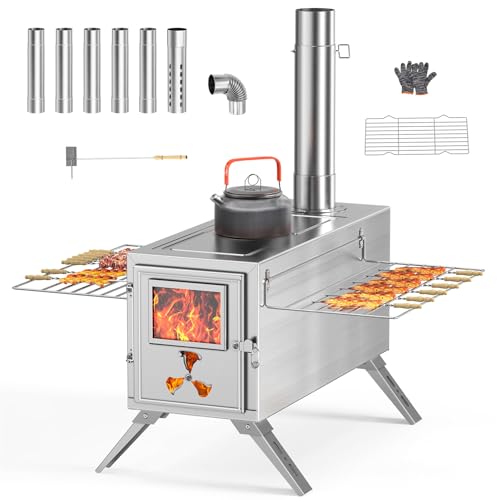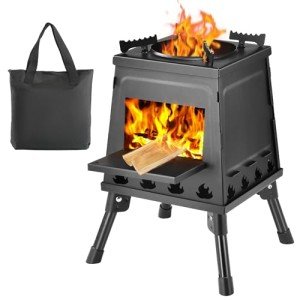In the realm of outdoor adventures, few experiences compare to the satisfaction of cooking a meal over an open flame in the heart of nature. For backpackers seeking a compact, lightweight solution, a portable wood burning camp stove emerges as a preferred option. This guide delves into the intricacies of these stoves, exploring their benefits, features, and the best practices for selecting the perfect model for your backpacking needs.
Why Choose a Portable Wood Burning Camp Stove?
Portable wood burning camp stoves offer a multitude of advantages that make them an appealing choice for outdoor enthusiasts. Here are some compelling reasons to consider going with wood as your primary fuel source:
-
Eco-Friendly: Wood burning stoves utilize natural materials, significantly reducing reliance on fossil fuels or single-use propane canisters. This makes them a more sustainable option for environmentally conscious campers.
-
Weight Considerations: Many wood burning stoves are designed to be lightweight, often weighing less than a traditional propane stove. They are usually constructed from durable materials such as stainless steel or titanium, ensuring they can withstand the rigors of backpacking.
-
Cost-Efficiency: Once initially purchased, wood burning stoves require minimal ongoing costs, as wood is typically free and abundantly available in nature. Backpackers no longer need to lug heavy fuel canisters on their journeys.
-
Versatility: Many models allow for the use of various fuel types, including twigs, pine cones, and dry leaves, providing flexibility in food preparation and cooking methods.
-
Enhanced Cooking Experience: Cooking over an open flame can enhance flavors in a manner that electric or propane stoves often fail to replicate. Many backpackers cherish the ritual of cooking over a fire, adding to the camping experience.
Key Features of Portable Wood Burning Camp Stoves
When selecting a portable wood burning camp stove, several features should be taken into account to ensure it meets your backpacking needs. Here is a list of essential features to consider:
-
Weight and Portability: Opt for a lightweight model that can easily fit within your backpack without adding unnecessary bulk.
-
Size and Cooking Capacity: Consider the number of people you’ll be cooking for. Some stoves are designed for solo travelers, while others can accommodate larger groups.
-
Material Quality: Look for stoves made of high-grade materials that can withstand high temperatures and resist corrosion, such as stainless steel or titanium.
-
Airflow Control: Efficient combustion is crucial for a good cooking experience. Stoves with adjustable airflow mechanisms allow for better control of the flame.
-
Assembly and Disassembly: Many models are designed for quick and easy setup. Look for stoves that are intuitive and do not require complicated assembly.
-
Multi-Fuel Capability: Some stoves are versatile enough to use different types of fuel. This feature is handy when wood isn’t readily available.
Popular Portable Wood Burning Camp Stoves
Various brands and models are available in the market, each offering unique qualities. Below is a selection of well-regarded portable wood burning stoves suitable for backpacking:
-
BioLite CampStove 2:
- Features a built-in fan for improved combustion.
- Can charge devices via USB, making it a dual-purpose option.
- Lightweight and compact design.
-
Solo Stove Lite:
- Simple design ensures easy setup.
- Efficient burn with minimal smoke production.
- Durable stainless steel construction.
-
Ohuhu Portable Camping Stove:
- Adjustable air intake for flame control.
- Lightweight and budget-friendly.
- Can burn wood, leaves, and other biomass.
-
TMS Portable Camping Wood Stove:
- Larger cooking surface for group meals.
- Sturdy metal construction and foldable design.
- Affordable and simple to use.
-
Lixada Camping Stove:
- Built-in pot support for stable cooking.
- Compact folding design for easy storage.
- Efficient and lightweight option.
Best Practices for Using Wood Burning Camp Stoves
Using a portable wood burning camp stove can be a rewarding experience, but it requires proper knowledge and practices for safety and efficiency. Below are some tips to keep in mind:
-
Choose the Right Location: Set up your stove in a clear area away from flammable materials. Ensure adequate ventilation to prevent smoke buildup.
-
Gather Dry Fuel: Collect dry twigs, leaves, and small branches before starting your fire. Dry materials ignite more easily and produce less smoke.
-
Build a Fire Structure: Start with a base of fine material (like dry leaves or small twigs) and gradually add larger pieces as the flame grows. A teepee or log cabin structure works well for airflow.
-
Practice Leave No Trace Principles: Always clean up after your meal and ensure that no remnants of your fire are left behind. Follow local regulations about campfires and wood gathering.
-
Safety First: Always have water or a fire extinguisher readily available for emergencies. Be cautious of local regulations regarding campfire safety.
FAQs about Portable Wood Burning Camp Stoves
Q: Can I use a wood burning stove in all camping locations?
A: No, not all campgrounds allow wood burning stoves. Always check local regulations, especially in fire-prone areas or during fire bans.
Q: What types of materials can I burn in a wood burning stove?
A: You can burn wood, dry leaves, pine cones, and other biomass. Avoid burning treated wood or materials that release toxic fumes.
Q: How do I clean my wood burning stove?
A: Allow the stove to cool completely, then remove ashes and debris. Wash the exterior with warm, soapy water, and dry thoroughly to prevent rust.
Q: Can I use a wood burning stove for boiling water?
A: Yes, wood burning stoves are effective for boiling water. Just ensure you have a suitable pot, and follow proper fire-building techniques for best results.
A portable wood burning camp stove provides backpackers with an eco-friendly and cost-effective means of preparing meals in the great outdoors. Their lightweight design, coupled with the enhanced culinary experience of cooking over an open flame, makes them an attractive option for nature enthusiasts. By considering key features and adhering to best practices, adventurers can enjoy the warmth and satisfaction of a fire-cooked meal, creating unforgettable memories on their outdoor escapades.






